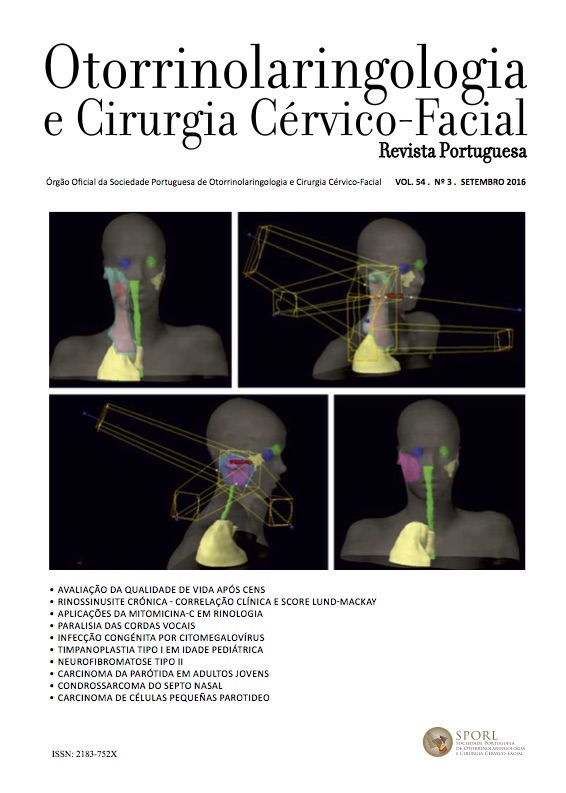Carcinoma da parótida em adultos jovens - a propósito de um caso clínico
DOI:
https://doi.org/10.34631/sporl.622Palavras-chave:
carcinoma, parótida, jovens, radioterapia, cirurgiaResumo
Cerca de 70% dos tumores das glândulas salivares surgem na parótida, dos quais 25% correspondem a neoplasias malignas. Estes tumores são raros nos jovens e tanto a sua incidência como a taxa de malignidade não só diferem dos adultos como o prognóstico da doença é mais favorável. Neste trabalho a propósito da descrição de um caso clínico, pretende-se realçar não só a existência desta incidência rara, como também as estratégias terapêuticas e suas controvérsias. Trata-se de uma doente, de 19 anos, com tumefacção de 4cm na região parotídea direita e parestesias no membro superior direito. A biópsia revelou um carcinoma mucoepidermóide da parótida, pelo que na sequência foi submetida a cirurgia e radioterapia pós-operatória. Presentemente, tem um follow-up de 42 meses, sem evidência de recorrência da doença. Uma vez que o carcinoma da parótida é raro em adultos jovens, serão necessários mais estudos para optimizar as estratégias terapêuticas a adoptar.
Downloads
Referências
Spiro J, Spiro, R. Cancer of the Parotid Gland: Role of 7th Nerve Preservation. World Journal Surgery. 2003; 27:863-867.
Halperin EC, Wazer DE, Perez CA, Brady LW. Perez and Brady’s Principles and Practice of Radiation Oncology, 6th Edition. Philadelphia, Lippincott-Williams & Wilkins; 2013: pp2350-2390.
Al-Naqeeb NI, Dashti H, Al-Muhanna AH, Behbehani A. Parotid gland tumours: a 15-year experience. Journal of the Royal College of Surgeons of Edinburgh. 1992; 37(2):89-93.
Diaz P, Castillo R, Plata M, Gías L et al. Clinical results in the management of Frey’s Syndrome with injections of Botulinum Toxin. Medicina Oral Patol Oral Cir Bucal. 2008; 13(4):E248-252.
Rutt AL, Hawkshaw MJ, Lurie D, Sataloff RT. Salivary gland cancer in patients younger than 30 years. Ear Nose Throat J. 2011; 90(4):174-84.
Meyers E, Ferris R. Salivary Glands Disorders. Springer 2007.
Armstrong JG, Harrison LB, Thaler HT, Friedlander-Klar H et al. The indications for elective treatment of the neck in cancer of the major salivary glands. 1992; Cancer 69:615.
Zbaren P, Schupbach J, Nuyens M, Stauffer E. Elective neck dissection versus observation in primary parotid carcinoma. Otolaryngol Head Neck Surg. 2005; 132:387.
Kelley DJ, Spiro RH. Management of the neck in parotid carcinoma. Am J Surg 1996; 172:695–7.
Nobis CP, Rohleder NH, Wolff KD, Wagenpfeil S et al. Head and neck salivary gland carcinomas - elective neck dissection, yes or no? J Oral Maxillofac Surg. 2014; 72(1):205-10.
Al-Mamgani A, Van Rooij P, Verduijn GM, Meeuwis CA et al. Long-term outcomes and quality of life of 186 patients with primary parotid carcinoma treated with surgery and radiotherapy at the Daniel den Hoed Cancer Center. Int J Radiat Oncol Biol Phys. 2012; 84(1):189-95.
Pohar S, Gay H, Rosenbaum P, Klish D et al. Malignant parotid tumors: Presentation, clinical/pathological prognostic factors, and treatment outcomes. Int J Radiat Oncol Biol Phys 2005; 61:112-118.
Terhaard CHJ, Lubsen H, Rasch CRN, Levendag PC et al. The role of radiotherapy in the treatment of malignant salivary gland tumors. Int J Radiat Oncol Biol Phys 2005; 61:103-111.
Richter SM, Friedmann P, Mourad WF, Hu KS et al. Postoperative radiation therapy for small, low-/intermediate-grade parotid tumors with close and/or positive surgical margins. Head Neck 2012; 34(7):953-5.
Stodulski D, Mikaszewski B, Stankiewicz C. Are all prognostic factors in parotid gland carcinoma well recognized? Eur Arch Otorhinolaryngol 2012; 269(3): 1019–1025.
Ghosh-Laskar S, Murthy V, Wadasadawala T, Agarwal J. Mucoepidermoid carcinoma of the parotid gland: factors affecting outcome. Head Neck 2011; 33(4):497-503.
Armstrong JG, Harrison LB, Spiro RH, Fass DE et al. Malignant tumors of major salivary gland origin. Arch Otolaryngol Head Neck Surg 1990; 116:290–293.
Terhaard CHJ, Lubsen H, Rasch CRN, Levendag PC et al. The role of radiotherapy in the treatment of malignant salivary gland tumors. Int J Radiat Oncol Biol Phys 2005; 61:103–111.
Terhaard CHJ, Lubsen H, Van Der Tweel, Hilgers FJ et al. Salivary gland carcinoma: independent prognostic factors for locoregional control, distant metastases, and overall survival: results of the Dutch Head and Neck Oncology Cooperative Group. Head Neck 2004; 26:681–693.
Therkildsen MH, Christensen M, Andersen LJ, Schiødt T et al. Salivary gland carcinomas-prognostic factors. Acta Oncol 1998; 37:701–713.
Fu KK, Leibel SA, Levine ML, Friedlander LM et al. Carcinoma of the major and minor salivary glands. Analysis of treatment results and sites and causes of failures. Cancer 1977; 40 (6): 2882-2890.
Poulsen MG, Pratt GR, Kynaston B, Tripcony LB. Prognostic variables in malignant epithelial tumors of the parotid. Int J Radiat Oncol Biol Phys 1992; 23:327–330.
Mendenhall WM, Morris CG, Amdur RJ, Werning JW et al. Radiotherapy alone or combined with surgery for salivary gland carcinoma. Cancer 2005; 103:2544–2550.
Chen WC, Liao CT, Tsai HC, Yeh JY et al. Radiation-induced hearing impairment in patients treated for malignant parotid tumor. Ann Otol Rhinol Laryngol 1999; 108(12):1159-1164.






